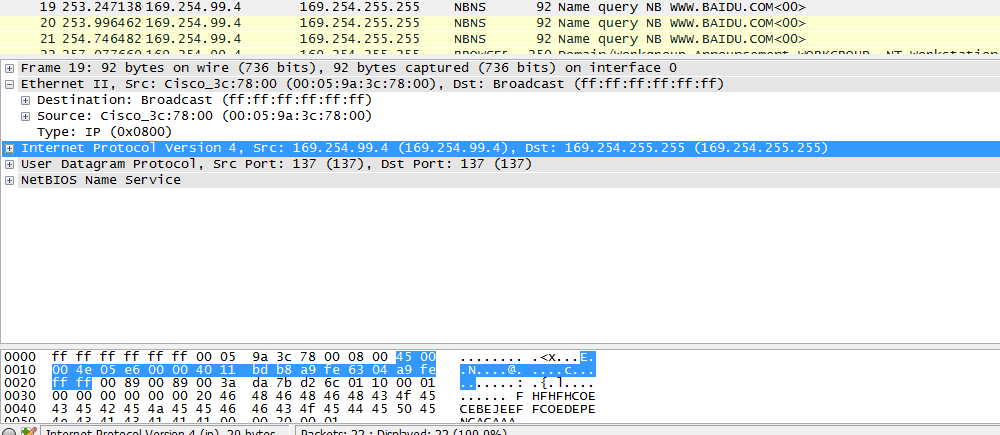Hi,
As said.. the lower layers are able to provide you with the information and you do not need the Ethernet packet length information for that. The NIC knows the
frame size it received from the wire (information comes e.g. from the PHY) and stores the information in some register for the driver to read it. As an example look how linux NIC drivers do this.
- Jouni
From:
马世佳 [mailto:mashijia@xxxxxxxxxxxxxxx]
Sent: Tuesday, November 10, 2015 7:43 AM
To: Jouni Korhonen; 'stds-1904-3-tf@xxxxxxxx'
Subject: 答复: hillsboro aftermath: timestamps/sequence numbers
Thanks,
Acturally,there are two types of Ethernet header . One is IEEE802.3 header (which include dest mac ,src mac,length ,type ) ,the other is Ethernet
II(which include dest mac, src mac, type ,there is no length filed), which is showed as below,

And I use wireshark to capture network packets ,I find there is no length filed in Ethernet II . So I feel very confused.

马世佳
移动研究院千人计划创新基地3-绿色通信研究中心
地址:北京市西城区宣武门西大街32号中国移动创新大厦18层,100053
马世佳
移动研究院千人计划创新基地3-绿色通信研究中心
地址:北京市西城区宣武门西大街32号中国移动创新大厦18层,100053
电话:010-15801696688-36058
Mobile::13910391546

发件人:
stds-1904-3-tf@xxxxxxxx [mailto:stds-1904-3-tf@xxxxxxxx]
代表 Jouni Korhonen
发送时间: 2015年11月10日 23:19
收件人: mashijia@xxxxxxxxxxxxxxx; 'stds-1904-3-tf@xxxxxxxx'
主题: RE: hillsboro aftermath: timestamps/sequence numbers
Hi,
Lower layers are able to provide you with the packet length information ? the length of the entire Ethernet frame, which should be enough unless packets less
actual payload than 64 bytes are sent. This is for example what NICs do today when they deliver the packets to upper layers for further processing. In my opinion the length information would not be useful in cases we are looking at.
- Jouni
From:
马世佳 [mailto:mashijia@xxxxxxxxxxxxxxx]
Sent: Monday, November 09, 2015 9:00 PM
To: 'Yasser Kilde Bajwa'; 'stds-1904-3-tf@xxxxxxxx'
Cc: Jouni Korhonen; 'kevin.bross@xxxxxxxxx'
Subject: 答复: hillsboro aftermath: timestamps/sequence numbers
Hi Jouni and Kevin,
I have a question,that when I only use MAC header and ROE header , how can I get the packet length from header?
Thanks.
马世佳
移动研究院千人计划创新基地3-绿色通信研究中心
地址:北京市西城区宣武门西大街32号中国移动创新大厦18层,100053
电话:010-15801696688-36058
Mobile::13910391546

发件人:
stds-1904-3-tf@xxxxxxxx [mailto:stds-1904-3-tf@xxxxxxxx]
代表 Yasser Kilde Bajwa
发送时间: 2015年11月9日
14:04
收件人: stds-1904-3-tf@xxxxxxxx
抄送: Jouni Korhonen;
kevin.bross@xxxxxxxxx
主题: RE: hillsboro aftermath: timestamps/sequence numbers
Hi Jouni and Kevin,
Apparently the reflector rejected my last mail so I try again with my signature removed completely.
Sounds great to remove the T flag.
I agree with the points brought up by Kevin except for the use of timestamp and sequence numbers only being based on packet type. I guess it’s
really a question going back to how we see the hierarchy of these 2 identifiers (Flow ID and packet type). We see Flow ID as the highest in this hierarchy with the different packet types as being right below that. Here we expected that the end points of that
flow would either use timestamps or sequence numbers which would be communicated out of band and be associated with the flow ID or possibly with a flow ID and packet type combination. If we associate it with the Packet type then we are essentially dedicating
one bit in the header just for this.
Regards,
Yasser
From:
stds-1904-3-tf@xxxxxxxx [mailto:stds-1904-3-tf@xxxxxxxx]
On Behalf Of Bross, Kevin
Sent: 6. november 2015 10:07
To: Jouni Korhonen <jouni.korhonen@xxxxxxxxxxxx>;
stds-1904-3-tf@xxxxxxxx
Subject: RE: hillsboro aftermath: timestamps/sequence numbers
Looks good. A few related thoughts:
1.
I think we should dump the extended header terminology entirely. Each pkt_type will determine the format of the payload.
2.
Should the use of timestamp or sequence be a function of pkt_type and flow_id, or should it be a function purely of pkt_type? [I think I would prefer the latter.]
3.
Does it make sense to break the timestamp/sequence into “Timestamp/sequence High Word” and “Timestamp/sequence Low Word”? This would still be a 32-bit composite field, but we could graphically
show the position of the high word and the low word in the packet layout diagrams like you show below.
Going with the logic that simpler is often better, I like how the header has simplified over the course of our discussions.
--kb
===================================================================
From:
stds-1904-3-tf@xxxxxxxx [mailto:stds-1904-3-tf@xxxxxxxx]
On Behalf Of Jouni Korhonen
Sent: Thursday, November 05, 2015 11:22 AM
To: stds-1904-3-tf@xxxxxxxx
Subject: hillsboro aftermath: timestamps/sequence numbers
Folks,
Coming back to discussion we had and kind of was let hanging on my next steps.. so the T-flag and alternating between sn/ts.. I am actually OK to go with what was proposed
during the meeting and toss the T-flag. If we need timestamps that can be decided per flow_id and packet type.
If folks agree with the above we would end up to a header as below:

So, everybody happy with this? I did collapse the extended_header_space and the payload into the same illustration, since they essentially are the same (subject to the packet
type).
- Jouni
--
Jouni Korhonen, CTO Office, Networking, Broadcom Corporation
O: +1-408-922-8135, M: +1-408-391-7160
=== MICROELECTRONICS TECHNOLOGY INC. ===
This message (and any attachments) may contain information that is confidential, proprietary, privileged or otherwise protected by law. The message is intended solely for the named addressee (or a person responsible for delivering it to the addressee). If you
are not the intended recipient of this message, you are not authorized to read, print, retain, copy or disseminate this message or any part of it. If you have received this message in error, please destroy the message or delete it from your system immediately
and notify the sender.